My next Himalayan Photography Tour is to the finest mountain landscapes and cultural centers of Lahaul & Spiti in Himachal Pradesh – July/August 2014. Join me on this tour to learn the nuances of making great landscape images. See Heart of the Himalayas Lahaul & Spiti Photography Tour for details.
To get an idea of what this place is like, do read these posts I wrote about my journeys to the region.
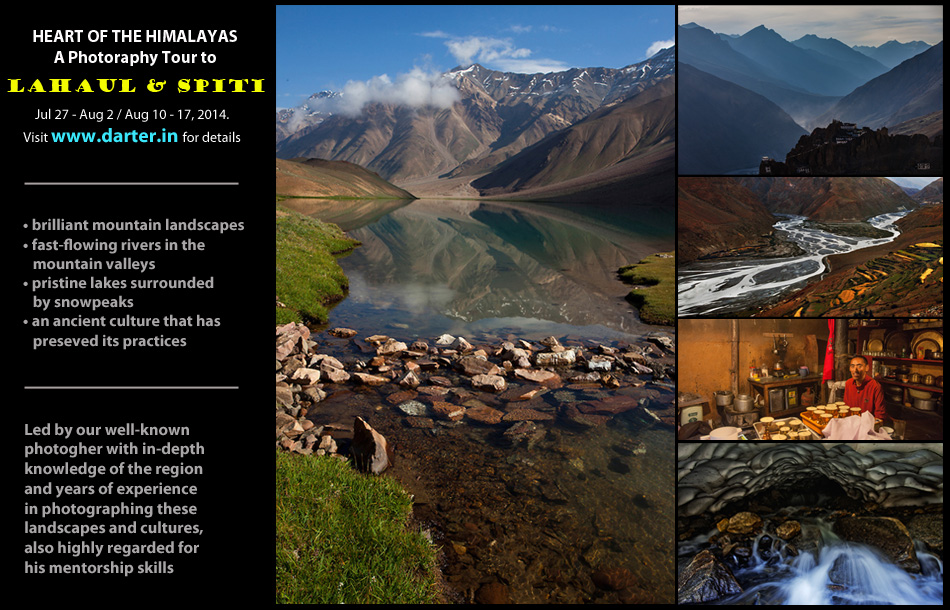
My photography tour to the finest mountain landscapes and cultural centers of Lahaul & Spiti in Himachal (Jul/Aug 2014). Join us – see http://bit.ly/lahaul-spiti-phototour for details.
Also see: Our photography tour to Ladakh in winter.
The pilot aligned the aircraft along the east-west direction of the Indus Valley before he reduced altitude. The aircraft gently zig-zagged in the sky, tracing the path of the azure river at the valley floor. With 6000 meter-high mountains rising steeply on either sides, the only way to descend into Leh was through the long-running trough of Indus River. From up in the sky, we followed the path of the river for a few minutes. When we had descended well below the altitude of the peaks that dominated the landscape, a steep U-turn at the widest part of the valley allowed us to make the final descent. We had arrived in Leh.
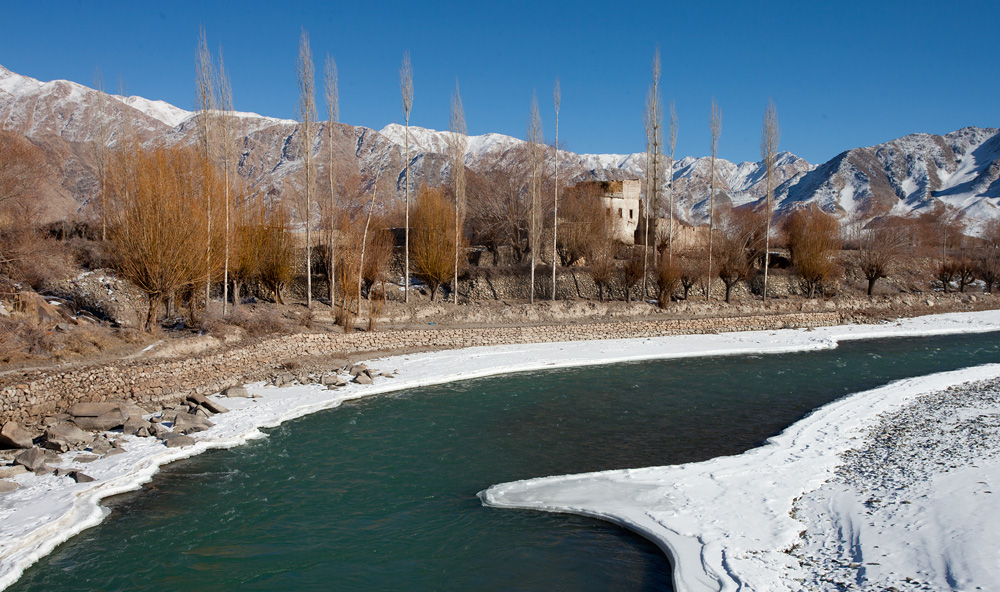
We taxied out of the runaway as the cabin crew made the usual announcements. For some reason, they decided not to mention the outside temperature, perhaps with a goodwill to let us stay comfortably in the warmth of the aircraft without worrying about the harsh weather that awaited us. It must have been anywhere between five to ten degrees below zero that morning, a comfortable day by local standards in winter.
A wave of cold pricked my face as soon as I stepped out of the aircraft. I was well protected with multiple layers of warm clothes that covered much of my body – good enough to help me survive the cold but never enough to make me feel cozy. Airline staff rushed us to the awaiting bus, asking us not to stay out for long. The bus, quickly filled up with passengers, took us to the terminal with much needed central heating. Out from the airport, it was again a short hop exposed to the cold before we were whisked away to our guesthouse in a waiting vehicle. It was a similar story on reaching the guesthouse, where we quickly got off the car and rushed into the warm interiors.
This was my fourth visit to Ladakh in as many years and a second one in winter months. Although temperatures never rose above the freezing point, it was warm compared to my last visit in the same season. The mountains weren’t as thickly covered in ice as they were during my previous visit. There wasn’t any snow to be seen on the roads.
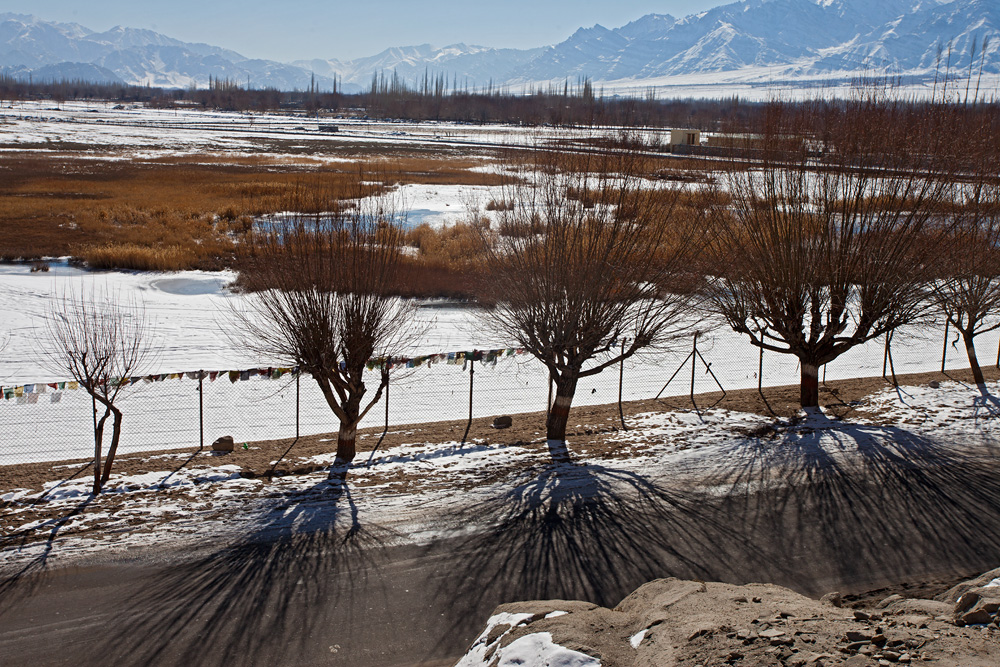
Compared to summer months, there were a few more things missing from the roads of Leh – vehicles and people. Falling mercury with the approach of winter had also brought a fall in tourist numbers. The shops selling curios, restaurants dishing out pizzas or Korean food, hotels of all sizes that dominate the landscape of Leh, the line of pigeon-hole enterprises with signs that announce “jeep safari, trekking,..” had all shut down until the next summer. Taxis that ferry the tourists had gone off the road. I peeked through a small enclosure with a sign that said ‘painteball arena’, only to see some clothes drying on a lane tied to poplar trees. ‘For six cold months, the busy tourist town goes silent. The few private vehicles occasionally seen on the roads belonged to the locals. The shops that stayed open catered to the residents and so did restaurants.
At ‘Friend’s Corner’, the most popular winter-time restaurant in the town, I saw only mongoloid-faced Ladakhis relishing on Thukpas and Chowmein. My host for the day’s lunch was Tundup, who runs a travel agency in Leh. He was spending his days mostly relaxed, but for some occasional planning for the upcoming summer rush. For the people of Ladakh, winter is a season for rest, festivities and merry making. The harsh winter weather doesn’t deter them; they are used to it.
A transition from summer to winter was also apparent in the landscape of Leh. The fields and gardens, which the people of the town and surrounding villages lovingly tend to, now stood brown and unattended. Poplar and willow trees had lost all their leaves. But the usually barren mountains had now come alive with a charming sprinkle of snow on their slopes.
It is this snow in the mountains and much larger deposits of it in the remote regions that has attracted me to Leh in winter. Two years ago, I had my first encounter with Ladakh’s winter over an expedition on the frozen Zanskar River, commonly called Chadar Trek. While I discovered how brutal the weather can get, I also fell in love in the snowy landscapes. I had now come back for more, to visit the frozen Pangong Lake and to drive on the snowfields that the eastern Changthang Plateau morphs into (more on these in another post).
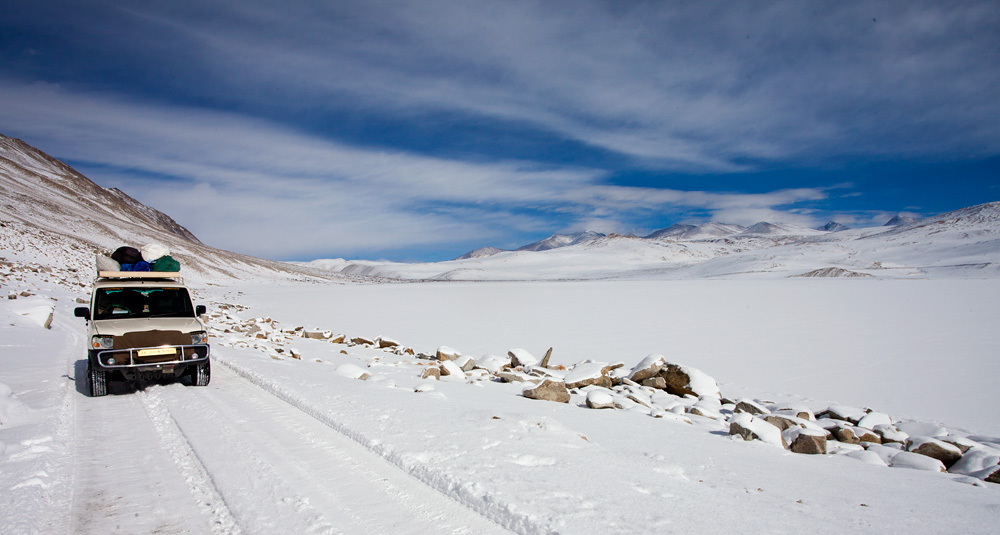
Roads filled with snow in Ladakh
So how is it, being in Leh in winter? It is a time of the year when you can’t take many things for granted, which you could have during a summer visit. It is important to plan for clothing elaborately, or you would find it hard even to get out of the airport. Most of the hotels remain closed, so it is essential to identify one that remain open, and book in advance. Those few that remain open necessarily offer heating, but almost no one will offer running water in the bathrooms (water freezes in the pipes). Only a handful of restaurants remain open in the main market, and finding one for dinner is not only a painful affair in the cold of the night, there will be even fewer that remain open compared to lunch time. Dinners almost always have to be at your hotel or guesthouse.
The roads in Ladakh, however, continue to stay open despite the harsh weather. Occasionally, snowbound high passes may be shutdown for a few days, but the Border Roads Organization works continuously to keep them open for vehicles. Visits to Pangong Lake (where temperatures dip to 30 below zero), Nubra Valley and Tso Moriri Lake continue to remain accessible.
The monasteries across Ladakh will also remain open, though most of the monks will be away and the activities will be reduced to a minimum. At Stakna Monastery, the only person we met was the caretaker-monk who was on duty , who opened the doors of the dukhang (prayer hall) for us. We moved quickly from prayer hall to the next temple and the next, unable to stand barefoot on a floor that seemed determined to freeze us. Outside the monastery, where it had just begun snowing, the village stood desolate as its people remained confined to the houses. Across the village, a deep blue Indus flowed gently, partially frozen on either sides.
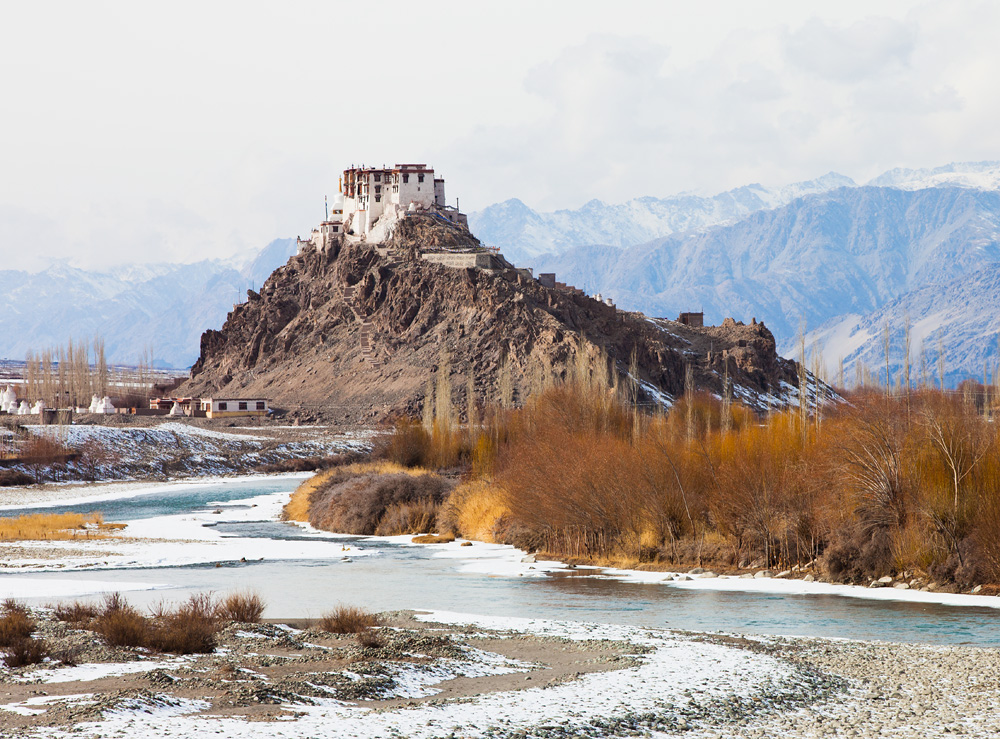
Indus River and Stakna Monastery
It was a similar story in Thiksey, where we were greeted to a near-empty monastery. As in Stakna, the only person we saw was the caretaker-monk. But in nearby Shey Village, it was a festival day with large gathering of people waiting to be blessed by the monks. We saw a congregation of a few thousands dressed at their best, patiently waiting for the activities to begin. Outside the monastery, many vendors had gathered, selling stuff as varied as ‘garam garam momos’, sun-dried apricots, ready-to-wear clothing and raw sheep wool.
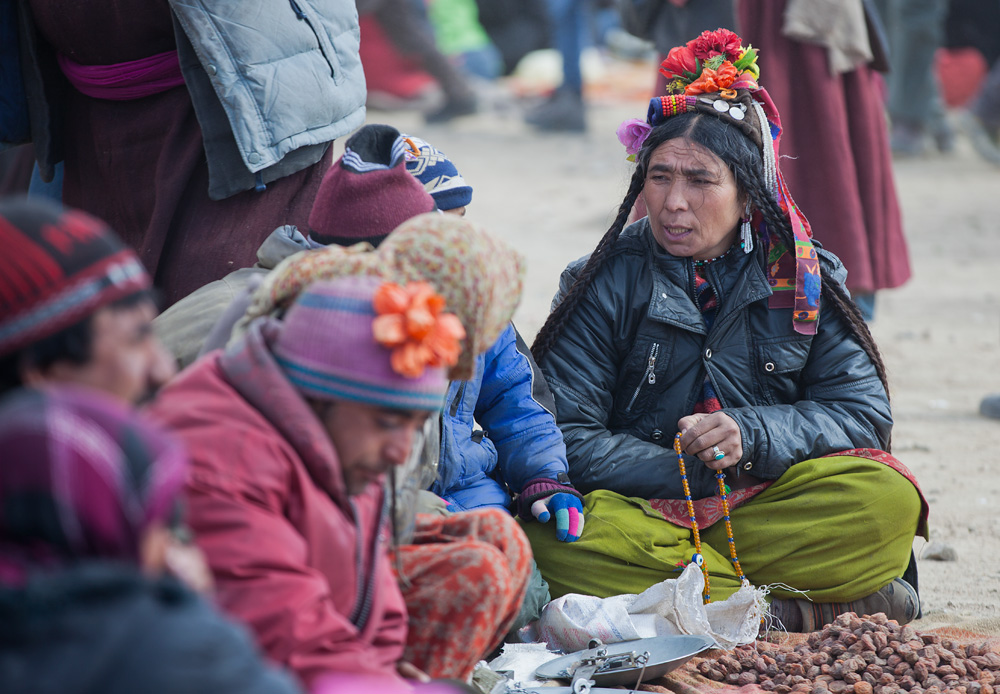
I bought some sun-dried apricots later in the day at Leh’s now quiet main-market. They tasted good, but were no match to the juicy apricots that you can simply pluck from a tree and relish during the summer days. There are many such pleasures that you can’t find in the winter months in Ladakh. Visitors have to endure the cold and live without the luxuries of summer. But the landscapes–snow-covered slopes, half-frozen rivers, fully frozen lakes, earth that looks like ice fields–are a splendid work of nature that can only be witnessed in this season.
As I plan and prepare for my second visit to Ladakh this winter in search of a frozen Pangong Lake, here is a short take on Chadar Trek and experiencing Ladakh in winter months.
Every year, ‘Ladakh Season’ begins some time in June and ends in September-October months. This is the fair weather time in Ladakh and is the best time to visit. This is also the time when the roads leading to Leh from Manali and Srinagar remain open. From late September or early October, weather gods cast their angry-eyes on this region and let the clouds play havoc on the mountains. Rains bring down tonnes of slush on the roads to Ladakh and snowfall makes things worse at high passes. Temperature dips closer to zero and goes further down with the progress of winter. Temperatures twenty below zero become an everyday affair from December to February. Naturally, the streets of Leh that used to be filled with visitors in summer now go nearly empty. Very few people make it to Ladakh in these months, thanks to the difficult weather and closed roads.
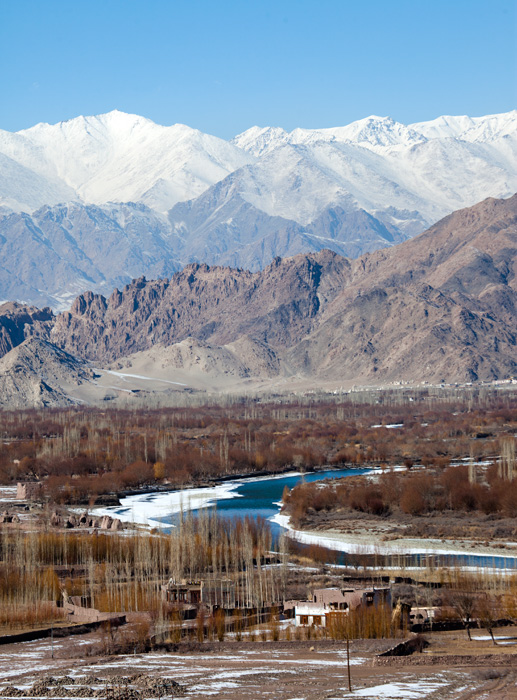
Landscapes of Ladakh in winter with Indus flowing through the mountains.
The landscape too, gets transformed during the winter months. Rivers that were running full in summer, thanks to the melting glaciers, now slow down. The barren mountains are now adorned with snow. Whatever few trees that exist in the valley shed their leaves and go naked. The fields that were filled with barley too, become either brown or white with snow. The sky however, becomes unpredictable: it is either stark blue or masked with clouds that precipitate powdery snow.
In summer months, Ladakh’s clear blue skies, stark landscapes and the deep valleys appear magical. As the temperature dips and the mountains prepare for a long winter, the transformation creates another kind of magic. It is made of deep blue rivers lined with ice on either banks, tall poplar groves that stand bare and parallel to each other, mountain peaks that keep changing colours from brown to white depending on the weather.
When it comes to people of Ladakh, life takes a slower pace in winter. The markets that cater to tourists shut down. The tourists walking on the street, who could be from any part of the world, disappear completely. The few people who are on the street are all round-faced, apple-cheeked Ladakhis going around doing their daily shopping.
In 2011 January, I made a winter visit to Ladakh and was amazed by the transformation that the landscape went through. I had seen it in pictures and knew what to expect, but as it always happens, the magnificence that unfolds in front of your eyes can’t be substituted by a two-dimensional post-card sized splash of colours. I was overwhelmed. I was taken. The winter time Ladakh had conquered me as soon as our aircraft landed at the airport in Leh.

Thiksey Monastery in winter.
I spent two weeks in Ladakh then, visiting a few monasteries that are typical tourist hangouts during the summer months, and then walking on the frozen Zanskar River in the excellent stewardship of Manish Lakhani, whose name is highly respected on the unpredictable tracks of Chadar. Having spent more than two months in Ladakh, I had assumed that I know plenty about the region. But this time, it all looked new. And different. The monastery at Thiksey was unpeopled, but for the caretaker monk in the Buddha Room who smiled at us genially. Empty landscapes and a super-blue Indus welcomed us at Stakna. The river that was in a great hurry during summer months, then filled with sediments it brought from faraway Tibet, was now clear and challenged the sky in its blueness.
Chadar Trek–the walk on the frozen Zanskar River–showed me a world that I had never known, a world that is hard to imagine it exists. Even when I had seen it in pictures. We lived for twelve days camping by the river during the night and walking on it during the day. On the way, we encountered waterfalls that had given in to the cold and had frozen on their way down the cliff. We saw whirlpools of water in Zanskar forming lily-like plates at the edge of the water. We walked on sections of the river where the it formed deep gorges, flowing between steep vertical walls. There were places where the river was frozen hard, forming a thick ice that could not even be broken by tonnes of heavy stones that fell from the mountains. At places, air bubbles showed through the transparent-blue ice. There were places where the ice was so fragile, we ended up having to walk in the frigid waters (not an experience I would want to repeat!).
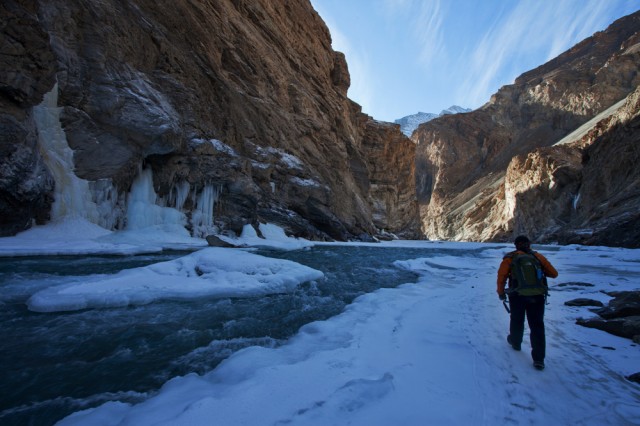
Chadar Trek – walking on the frozen Zanskar River.
As the days progressed over the Chadar, the landscapes changed one day and the steep inaccessible mountains made way to a wide open valley. Near Hanumil Village, where the habitation begins in Zanskar Valley, we could leave the river bed and walk on the gentle slopes. It is astonishing to see a civilization thriving in a place so remote and forbidden.
People of Zanskar once lived with the help of their livestock and subsistence farming. They consumed what they produced, relying on external world for very few essentials like salt, which was traded for yak butter. While there were many routes to connect with the external world during the summer months, the mountains routes were buried in snow during the winter. However, the river came to rescue when the mountains would not. The frozen river provided a faster, easier access to people of Zanskar with the outside world. This remains true remains even today. Once the snowfall begins in November, the roads to Zanskar are cutoff and river becomes the road that connects people with rest of the world.
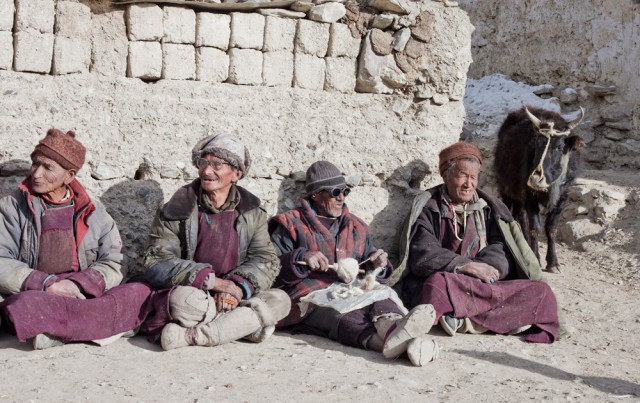
People of Zanskar, where life hasn’t changed much over the past centuries.
Much like the tradition of using the river for winter transport, lives of Zanskaris hasn’t changed much over the centuries. People still live largely on subsistence farming and depend considerably on their livestock. But income is supported by activities associated with tourism in the last few decades. In winter, a large pool of locals double up as porters for visitors who want to trek on Chadar. Business is generated in summer months by a continuous stream of visitors who come here to see places, go rafting or trekking. The roads, as long as they are open, also bring in modern facilities. Zanskar today has limited access to electricity, roads and reasonably good facilities to educate local children. Cooking gas cylinders have replaced cow-dung and wood. Yet, for a visitor who comes here in winter, it is difficult to digest the fact that a civilization happily thrives here despite the harsh conditions, living far more contented than the people in the plains.
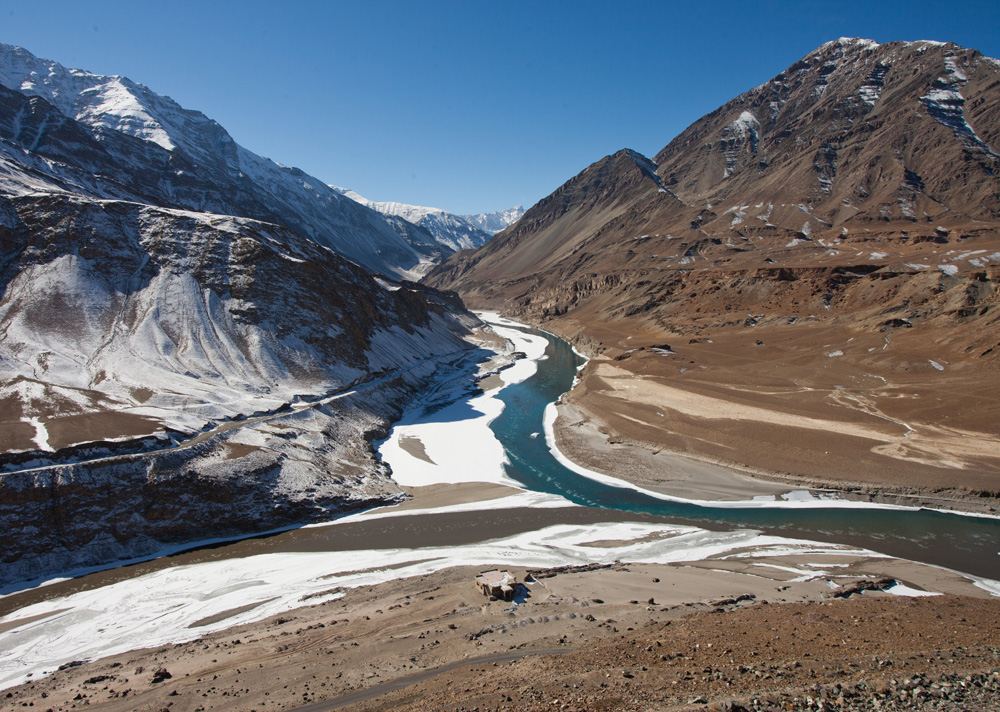
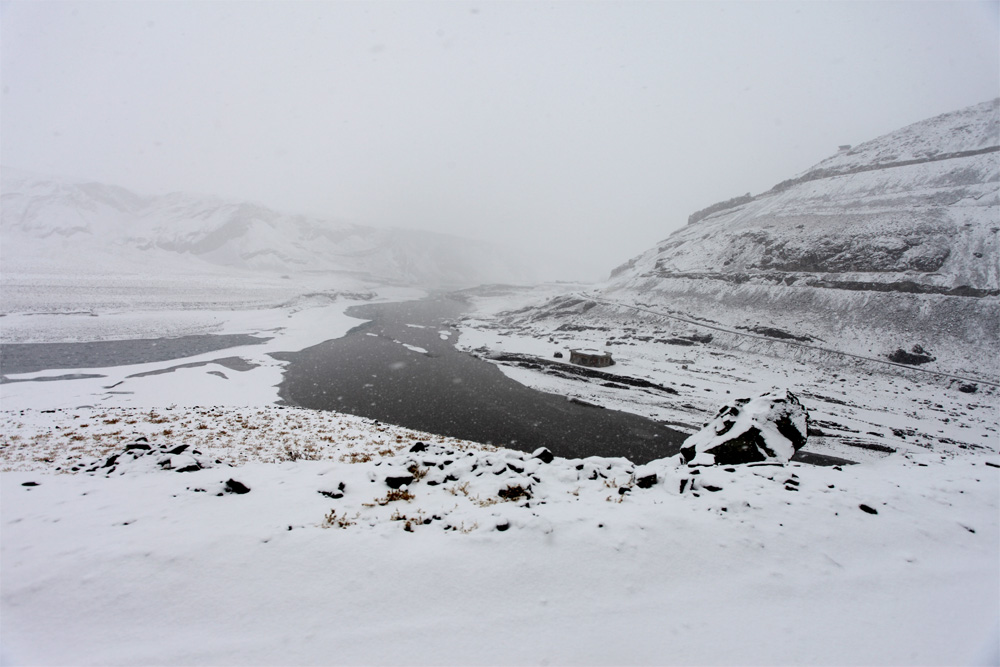
This is how things changed with weather at Nimu, the confluence of Indus and Zanskar Rivers.
We had clear blue skies as we walked upstream into the heart of Zanskar. On our way back however, weather gods decided to show us their powers. One morning, we woke up to see that the sun had disappeared behind thick, low-hanging clouds. It kept snowing for a long time, rarely offering any breather all through our return journey. Once again, the landscape was transformed. Fresh, powdery snow took the place of hard ice. Blue skies had changed colour and visibility had dipped. The confluence of Indus and Zanskar Rivers, which was an aesthetic mix of deep blue and mountain-brown when we began the trek, had turned into shades of grey when we ended. During the drive back to Leh, we did not see the road but a thick white line with little bit of tarmac showing up once in a while. The mountains hid behind the falling snow and there was nothing visible except the falling snow right ahead of us. With a continuous snow fall, my Ladakh experience was as complete as it could get. I had spent a summer here, relishing the balmy weather and driving through the high passes. I had seen rainy days when floods washed away our roads. I had seen clear-blue-sky days in summers and winters. Now, just as I was ready to depart after a long and tiring trek, Ladakh had transformed again and showed me yet another face that I had not seen before.
Also see: our photography tour to a Snow filled Ladakh in Winter.











